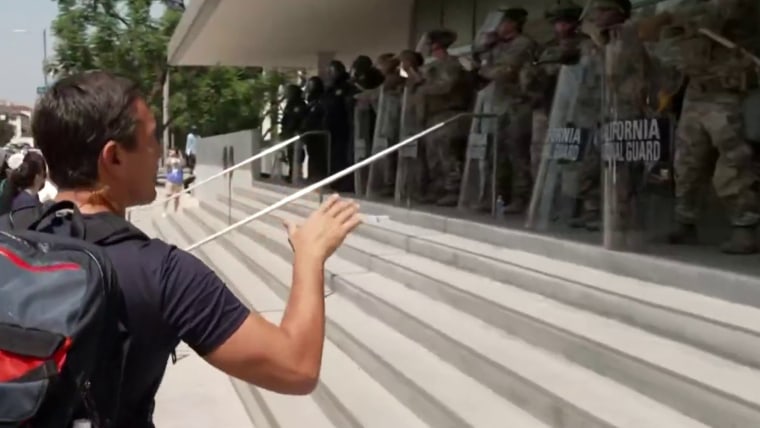President Donald Trump is trying to justify his decision to deploy National Guard troops to the Los Angeles area this weekend by describing protesters broadly as violent “insurrectionists” hell-bent on destroying the city. It’s a dishonest claim meant to delegitimize protest — and it foreshadows a more sinister power grab.
Here’s a quick overview of the events leading up to Trump’s insidious intervention.
Make no mistake: The real escalation here came from Trump.
On Friday, protesters took to the streets in response to a series of federal immigration raids across L.A. at places including a clothing store and areas where day laborers gather to find work. According to The Guardian’s detailed timeline of the demonstrations over the weekend, those protests were “mostly peaceful,” involving a few hundred people concentrated in downtown L.A. At times, authorities acted aggressively toward nonviolent protesters. David Huerta, the president of Service Employees International Union California, was “arrested while apparently doing little more than standing and observing one of the immigration raids,” according to The Guardian. The LAPD used tear gas to break up a crowd after a “tense but largely non-violent standoff” with police, per The Guardian.
On Saturday, protesters demonstrated in Paramount, a small city 20 miles south of downtown L.A., where federal agents were rumored to be conducting more raids. Protesters reportedly numbering in the hundreds gathered outside places they believed to be the site of raids. According to The New York Times, some threw rocks and other objects at law enforcement vehicles, and law enforcement officials responded by tear-gassing them. As clashes with law enforcement intensified over the course of the afternoon, protesters set three fires — including one of a vehicle in a street intersection, according to The Guardian.
It was at this point — early Saturday evening — that Trump decided that he wanted to send in National Guard troops to quell a “rebellion.” And, with that, he gave away the game.
Did those protests sound raucous and like the kind of thing that could escalate? Yes. Were they the kind of protests that imminently required law enforcement power beyond the vast resources of Los Angeles County and the state of California? Absolutely not. By the standards of American protests and riots, these actions were mostly contained. Yet, Trump signed a memo sending 2,000 National Guard troops to California — overriding the objections of California Gov. Gavin Newsom and Los Angeles Mayor Karen Bass.
“Let’s be real about this,” Bass said at a Sunday news conference. “This is about another agenda. It’s not about public safety.” Newsom said in a statement, “We didn’t have any problem until Trump got involved,” and he called Trump's sending in the National Guard a “breach of state sovereignty” that would only inflame the situation.

Make no mistake: The real escalation here came from Trump.
Trump preposterously claims that he saved L.A. from being “completely obliterated,” when in reality he has only increased tensions between protesters and the police and made the clashes more high-profile. On Sunday — after National Guard troops were deployed — L.A. Police Chief Jim McDonnell observed that the protests were “getting increasingly worse and more violent.” I would venture to guess that Trump’s aggressive attempts at repression are likely to cause a surge in protest activity, both nonviolent and violent, precisely because he has turned the situation into a showdown and a show of force.
And Trump’s attempts to describe the protesters as mounting an “insurrection” — a violent effort to overthrow the government — ring hollow as the protests broadly are clearly dissenting against Trump’s mass deportation campaign. This is obvious from the signage and chants of the protesters and the fact that they’re gathering at places associated with immigration raids to register their objections.
Trump’s actions are deeply alarming on a legal level. Elizabeth Goitein, senior director of the Liberty and National Security Program at the Brennan Center for Justice, described his decision to deploy National Guard troops in the manner he has as “completely unprecedented” and noted that “the use of the military to quell civil unrest is supposed to be an absolute last resort.” And New York University law professor Ryan Goodman has pointed out that in Trump’s memo federalizing the National Guard, Trump includes First Amendment-protected protest in his definition of a “rebellion” against the U.S. government. “Such a claim would make authoritarians blush,” he said.
Trump's potential future use of the Insurrection Act looms on the horizon. The rarely used law would be more dangerous than the order he just used to federalize National Guard troops, because it would expand what kinds of armed forces he could deploy and because those forces would have more expansive law enforcement capabilities under the act. As Rachel VanLandingham, a law professor at Southwestern Law School, recently pointed out for MSNBC, Trump's provocation has made that outcome likelier: "By inflaming tensions by sending in federal troops ... Trump may have created the need to invoke the Insurrection Act, thus allowing him to order not only the National Guard, but also active duty troops to police the streets of Los Angeles."
There wasn’t a real crisis in L.A. until Trump intervened. But that's exactly what he wanted.

